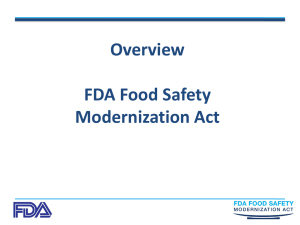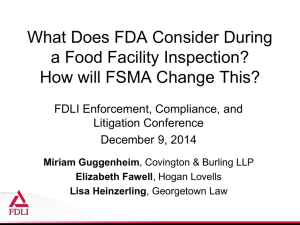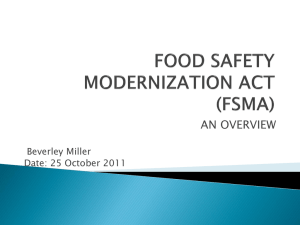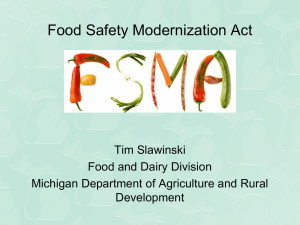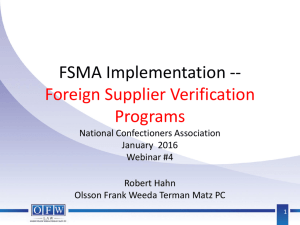Slides
advertisement
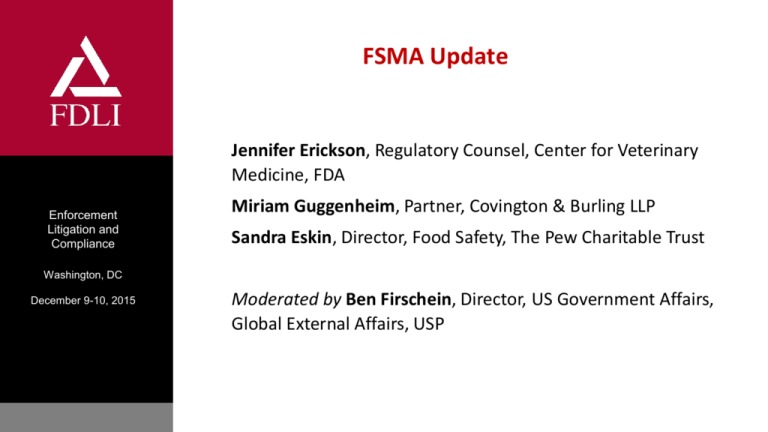
FSMA Update Jennifer Erickson, Regulatory Counsel, Center for Veterinary Medicine, FDA Enforcement Litigation and Compliance Miriam Guggenheim, Partner, Covington & Burling LLP Sandra Eskin, Director, Food Safety, The Pew Charitable Trust Washington, DC December 9-10, 2015 Moderated by Ben Firschein, Director, US Government Affairs, Global External Affairs, USP FSMA Updates Jennifer Erickson, JD FDA Center for Veterinary Medicine Rule Status Rule Status Date Preventive Controls Rule for Human Food Final Rule Published 9/17/15 Preventive Controls Rule for Animal Food Final Rule Published 9/17/15 Standards for Produce Safety Final Rule Published 11/27/15 Foreign Supplier Verification Final Rule Published 11/27/15 Third-Party Accreditation Final Rule Published 11/27/15 Sanitary Transportation Final Rule in Progress April 2016 Intentional Adulteration Final Rule in Progress June 2016 Guidance in Progress • Current list of FSMA related guidance: http://www.fda.gov/Food/GuidanceRegulatio n/FSMA/ucm253380.htm • Additional anticipated guidance: – Human Food Hazards and PC – Animal Food Hazards and PC – Animal Food CGMP – Human Food By-products for use as Animal Food FSMA Technical Assistance Network • Web portal for all stakeholders to submit FSMArelated questions • Once question is submitted you get a notification of receipt and case number • Question is routed through information specialists or subject matter experts for response • Questions will be tracked and trended to: – assist in prioritization of policy, guidance, and training – Develop a list of FAQs. FSMA Technical Assistance Network FDA Staff Preparedness • Program Alignment Group (PAG) – Identifying our food safety staff • Ongoing FSMA discussions – FDA and regulatory partners • Staff Training – FSPCA course – DHRD course Implementation Resources • • • • • FDA FSMA (general website) FDA Training Information Food Safety Preventive Controls Alliance FSMA Frequently Asked Questions FSMA Technical Assistance Network FSMA Update: Preparing for Compliance FDLI Enforcement, Litigation, & Compliance Conference December 9, 2015 Miriam Guggenheim Covington & Burling LLP Preparing for Compliance • Read key rules for industry and know their compliance dates (for large businesses) – HARPC – September 19, 2016 – FSVP – May 27, 2017 – Produce safety – see rule; it’s complicated! • Understand scope and exemptions • Understand key definitions and concepts • Understand what FDA expects – records, records, records! FSMA Core Concept – Ensuring a Culture of Compliance • Taking full responsibility for assuring the safety of the food you produce • Building food safety into the sourcing and production process • Knowing your suppliers and the nature of the food you produce • Keeping abreast of latest food safety developments and risks – Scientific developments (salmonella in peanut butter) – Economic adulteration (melamine) • Taking corrective action where needed, in accordance with predetermined approach Hazard Analysis and Risk-Based Preventive Controls (HARPC) in a Nutshell • For each type of food manufactured, processed, packaged, or held at a covered facility, must develop a written food safety plan that includes: – A hazard analysis – Preventive controls – Oversight and management of preventive controls • Verification activities • Monitoring of PCs • Corrective actions • • These activities must be conducted or overseen by a preventive controls qualified individual (“PCQI”) Must document everything, and make available to FDA upon request Preventive Controls Qualified Individual (“PCQI”) • Has completed training in the development and application of risk-based PCs at least equivalent to a curriculum recognized by FDA; or • Is otherwise qualified through job experience to develop and apply a food safety system • HACCP training/job experience may be sufficient Focus on Key Definitions • “Known or reasonably foreseeable hazard” – A biological, chemical, radiological, or physical agent that could cause illness or injury and is known to be (or has the potential to be) associated with the facility or the food • “Hazard requiring a preventive control” – A “known or reasonably foreseeable hazard” for which a knowledgeable person would establish 1+ PCs to significantly minimize or prevent the hazard • Must assess (1) the probability that the hazard will occur in the absence of PCs; and (2) the severity of the resulting illness/injury 14 Compliance and Enforcement Considerations • Will FDA question the qualifications or judgment of your PCQI? • Will FDA question your PCQI’s determination of hazards requiring a preventive control? • Will FDA question the adequacy of your preventive controls? • Will FDA promulgate guidance through warning letters? FSVP Core Requirements Overview • An importer must, for each food that it imports, implement an FSVP for each foreign supplier before importing a food into the United States as necessary to provide assurance that hazards in food requiring a control are significantly minimized or prevented • The FSVP must include: – a written hazard analysis – an evaluation of the risks posed by a food and the foreign supplier’s performance – supplier verification activities to allow the importer to approve the foreign supplier, and – corrective action procedures Key Definitions • “Importer” is the U.S. owner or consignee of an article of food that is being offered for import into the United States. – If there is no U.S. owner or consignee, then the importer will be the U.S. agent or representative of the foreign owner or consignee, as confirmed in a signed statement of consent. – “Owner or consignee” replaces the provision in the proposed rule that made the importer the purchaser of the food, or if there is no purchaser, the U.S. consignee. • “U.S. owner or consignee” is defined as the “person in the U.S. who, at the time of entry, owns the food, has purchased the food, or has agreed in writing to purchase the food.” • So first step is to determine whether you or someone else is the importer Relevant Exemptions/Modified Requirements • • • • An importer that is also a registered food facility and is controlling hazards under the HARPC rule need not comply with the majority of the FSVP rule. An importer who has established and implemented a risk-based supplychain program is deemed to be in compliance with FSVP requirements. Juice, fish, and fishery products from foreign suppliers who are required to comply with, and are in compliance with, the relevant HACCP regulations are exempt from FSVP requirements. For the importation of “covered produce” subject to the produce safety rule, the importer’s hazard analysis of that food need not include an analysis of biological hazards, because those hazards are covered by the produce rule. Questions/Discussion? Miriam Guggenheim Covington & Burling LLP 202-662-5235 mguggenheim@cov.com The Role of Audits in Determining FSMA Compliance Sandra B. Eskin Director, Safe Food Project The Pew Charitable Trusts 901 E Street NW, 10th Floor | Washington, DC 20004 Work phone: 202-540-6407| Cell phone: 301-602-1918 seskin@pewtrusts.org| www.pewtrusts.org “FDA-certified” Auditor The FDA Food Safety Modernization Act (FSMA), creates an “FDA-certified” auditing program to be used in two specific instances -1) if FDA determines that a “hi-risk” imported product/foreign facility requires “extra assurance” that it is safe; or 2) to qualify an importer to participate in the voluntary “fast-track” import program known as “VQIP” (Voluntary Qualified Importer Program). Preamble to the Final FSVP Rule • “Any qualified auditor conducting an audit relied upon by an importer would need to meet the requirements for independence set forth in [our regulations, which require no financial conflicts of interest and that payment must not be related to results of audit].” • “We believe that a person need not be an auditor formally accredited under the third-party certification regulations or any other accreditation system to have the technical expertise needed to appropriately perform an onsite audit.” FSVP Definitions • Audit means the systematic, independent, and documented examination . . . to assess an audited entity’s food safety processes and procedures. • Qualified auditor means a person who is a qualified individual . . . and has technical expertise, training, or experience (or a combination thereof) necessary to perform the auditing function. • Qualified individual means a person who has the education, training, or experience (or a combination thereof) necessary to perform an activity required under this subpart, and can read and understand the language of any records that the person must review in performing this activity. More From the Preamble to the Final FSVP Rule “The FSVP regulations do not require that a qualified auditor or qualified individual be accredited under any accreditation scheme or system, including FDA’s, as long as otherwise satisfies the requirements to be a qualified auditor or individual [as those terms are defined in the regulations].” Preamble to the Final Produce Rule • “[T]hird party audits are an important part of our overall compliance strategy.” • “ [A]s a complement to State and FDA inspections of farms, we intend to leverage the conduct of reliable third-party farm audits by USDA and others, as well as compliance with marketing agreements, with a goal of annual verification of farms that must comply with the rule.” More from the Preamble to the Final Produce Rule • “Adequately rigorous and reliable private audits can be an important additional tool for fostering food safety and ultimately compliance with this rule.” • “FDA is not recognizing any auditing body in this produce safety rulemaking.”


